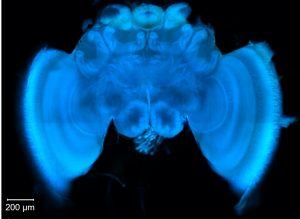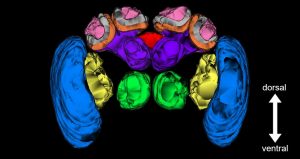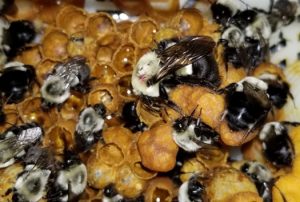**The AGA grants EECG Research Awards each year to graduate and post-doctoral researchers who are at a critical point in their research, where additional funds would allow them to conclude their research project and prepare it for publication. EECG awardees also get the opportunity to hone their science communication and write three posts over their grant tenure for the AGA Blog. In the first in the series, our EECG awardees write about their research and their interests as an ’embarkation’.

About the Author Mal Hagadorn (@DahBeesKnees) is fascinated by insects! She worked on scarab beetles during her BS and MS. Now, as a PhD candidate in Dr. Karen Kapheim’s lab at Utah State University, Mal uses bees to investigate relationships between sociality and neuroplasticity. She was awarded the EECG in 2021.
How can a lifestyle evolve where only a few individuals reproduce while most spend their lives caring for siblings? Addressing this broad question, Mal’s dissertation investigates how sociality influences neuroplasticity (i.e. brain changes over a lifetime) and drives brain investment patterns. First, she explored the effects of social environment on neuroplasticity in a solitary bee (Hagadorn et al. 2021) and now is working towards characterizing brain plasticity and neural circuitry associated with brood care in bumble bees.

Cooperation between female castes (queens and workers) is a hallmark of advanced social life (Wilson 1971), whereby reproduction is dominated by a few while the majority forego their own direct fitness benefits to care for siblings (Wilson 1971; Michener 1974). Sibling care behaviors are considered to be developmentally homologous to and evolutionarily derived from maternal care (Evans and West-Eberhard 1970; West-Eberhard 1987; West-Eberhard 1996). One prominent hypothesis for the origin of alternative female castes is the heterochronic decoupling of reproduction and maternal care behaviors (West-Eberhard 1996), such that the expression of maternal care occurs pre-reproductively in the workers (i.e., sibling care) (West-Eberhard 1996; Linksvayer and Wade 2005).

Underlying this hypothesis is the prediction that maternal and sibling care should be regulated by similar neurodevelopmental and neuromolecular mechanisms—a ‘maternal brain’ primed for taking care of brood. This raises the following questions: What does a ‘maternal brain’ look like? Is ‘mom brain’ consistent between castes? Are workers born with brains “primed” for brood care? If so, could this have facilitated the early expression of sibling care in workers?

The majority of Mal’s PhD focuses on addressing these questions. She is using bumble bees to evaluate relationships between developmental plasticity and the temporal expression of brood care to characterize the maternal brain. Bumble bees are great for investigating maternal brains because both castes exhibit brood care behaviors and worker egg-laying can occur (Goulson 2010). In two separate experimental phases, Mal will address both neurodevelopmental and neuromolecular aspects of the maternal brain. The first compares neurodevelopmental states of bumble bee queens and workers engaging in brood care using behavioral manipulations, confocal microscopy, and structure-specific volumetric analyses to decouple the effects of reproduction and brood care on large-scale neuroanatomical plasticity. For the second, which is funded by the EECG, Mal will use mRNA fluorescent in situ hybridization (FISH) in queens and workers to localize and quantify brood care-associated dopaminergic and octopaminergic neurons, two neurotransmitters with links to social behavior in insects (Kamhi et al. 2017). As with phase one, she will use behavioral manipulations to foster an environment where the effects of egg-laying and brood care can be decoupled, as well as assessed together. Ultimately, this approach will enable Mal to map out the maternal brain at a finer scale.

References
Evans HE and West-Eberhard MJ (1970) The wasps. University of Michigan Press.
Goulson D (2010) Bumblebees: Behaviour, Ecology, and Conservation. Oxford University Press.
Michener CD (1974) The social behavior of the bees: a comparative study. Harvard University Press.
Wilson EO (1971) The insect societies. Harvard University Press.



